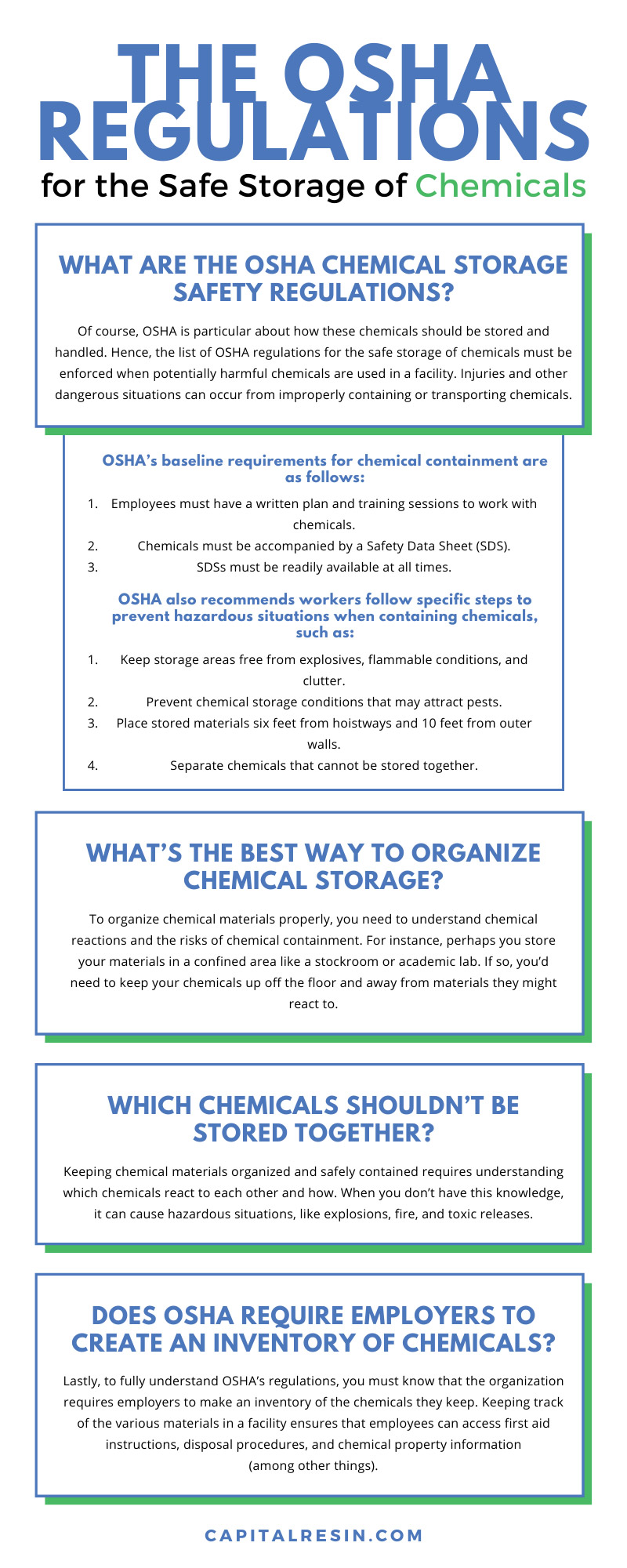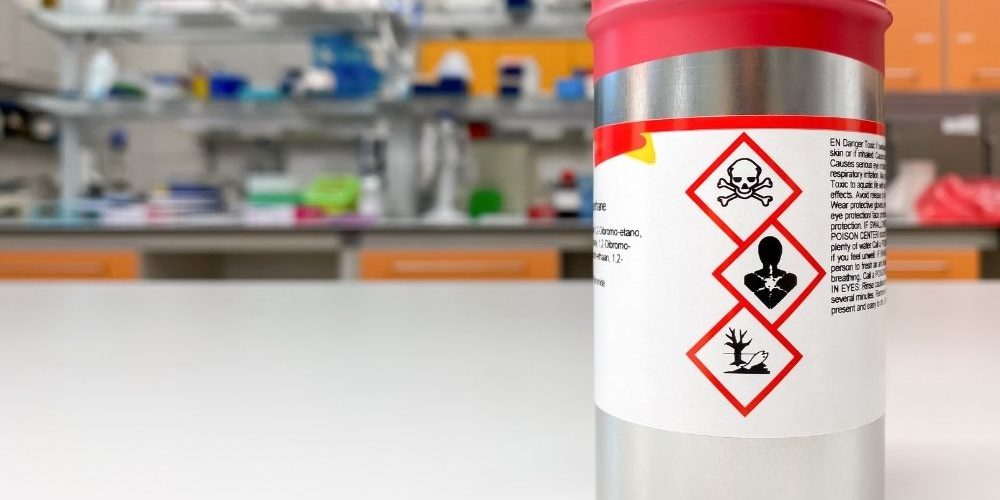OSHA is a renowned organization with a remarkable job. They ensure people across every occupational field are protected while on the job. Of course, this includes the chemical manufacturing and tolling industries. Because chemicals can be very hazardous when not handled or stored correctly, OSHA has specific rules for the proper storage of hazardous chemicals. Read this detailed guide to learn more about these regulations and why they’re essential.
What Is OSHA?
Before we delve into the OSHA regulations for the safe storage of chemicals, a firm understanding of what this organization is—moreover, what it does—is required. To start with, OSHA is an acronym that stands for “The Occupational Safety and Health Administration.” This federal agency is responsible for establishing and enforcing on-the-job safety protections for workers.
Their rules and regulations are not always the most convenient. But they are essential to the protection and well-being of our workforce. You could also say that OSHA plays a certain role in the success of our economy. After all, their regulations prevent illnesses, injuries, and other incidents that would otherwise burden the healthcare system and cause workers to lose their wages.
OSHA is the agency that ensures you stay out of harm’s way while on the job. They’re also the people who protect workers when hazardous incidents happen within a workplace. In short, they’re an important organization.
What Does OSHA Perceive as a Hazardous Chemical?
We’ve established OSHA as an organization that ensures safety in the workplace. This isn’t just exclusive to small businesses and construction sites, either. It also applies to chemical manufacturers and chemical tolling companies like us. As you can imagine, OSHA has quite a few rules and regulations for work environments that deal with hazardous chemicals.
But what exactly is a hazardous chemical in the eyes of OSHA? We’re glad you asked. OSHA defines dangerous chemicals as any chemical that can risk someone’s health or physical well-being. Chemical manufacturers determine the potential dangers of these chemicals based on what’s in their facilities.
But there are a few materials that are common to chemical manufacturing that’re typically always determined hazardous, including:
- Explosives
- Gases
- Flammable materials
- Oxidizing agents
- Toxic or infectious substances
- Corrosive substances
- Radioactive substances
What Are the OSHA Chemical Storage Requirements?
Of course, OSHA is particular about how these chemicals should be stored and handled. Hence, the list of OSHA regulations for the safe storage of chemicals must be enforced when potentially harmful chemicals are used in a facility. Injuries and other dangerous situations can occur from improperly containing or transporting chemicals.
According to the official OSHA chemical storage guidelines, workers should be aware of procedures that could result in the incorrect handling of chemicals or unhealthy situations. And when you consider that hazardous chemicals pose risks to workers health and safety, even when they’re not transporting them, this awareness becomes more crucial.
But those are just the broad strokes. To fully understand these regulations, we need to explore the specifics. Fortunately, we’ve taken some time to outline the essential rules and guidelines.
OSHA’s baseline requirements for chemical containment are as follows:
- Employees must have a written plan and training sessions to work with chemicals.
- Chemicals must be accompanied by a Safety Data Sheet (SDS).
- SDSs must be readily available at all times.
OSHA also recommends workers follow specific steps to prevent hazardous situations when containing chemicals, such as:
- Keep storage areas free from explosives, flammable conditions, and clutter.
- Prevent chemical storage conditions that may attract pests.
- Place stored materials six feet from hoistways and 10 feet from outer walls.
- Separate chemicals that cannot be stored together.
What’s the Best Way To Organize Chemical Storage?
Separating chemicals and keeping them specific distances away from other objects requires a detailed organization system. So how exactly does a facility go about organizing its chemical materials in a way that earns them the OSHA stamp of approval? We’re glad you asked.
To organize chemical materials properly, you need to understand chemical reactions and the risks of chemical containment. For instance, perhaps you store your materials in a confined area like a stockroom or academic lab. If so, you’d need to keep your chemicals up off the floor and away from materials they might react to.
Moreover, you’d want to store liquid chemicals in unbreakable packaging. Then, package it again with a secondary form of containment, such as a chemical storage cabinet. You’d also want to use clear labeling and lock up these cabinets to prevent people from accessing them without authorization.
Which Chemicals Shouldn’t Be Stored Together?
As we’ve mentioned briefly, keeping chemical materials organized and safely contained requires understanding which chemicals react to each other and how. When you don’t have this knowledge, it can cause hazardous situations, like explosions, fire, and toxic releases.
Thus, we’ve decided to share four common chemicals and their incompatible counterparts. This way, you can glimpse what should and should not be stored together.
- H20: Water is reactive to a slew of chemicals which include acetyl chloride, chromic acid, and sulfur trioxide.
- Nitric acid: Nitric acid shouldn’t be stored with acetone, alcohol, hydrocyanic acid, or flammable substances.
- Zinc powder: Used in paint, batteries, and cosmetics, zinc powder should be stored far from sulfur.
- Chlorine: Chlorine shouldn’t be stored near ammonia, benzene, butadiene, hydrogen, petroleum gases, sodium carbide, or turpentine.
Does OSHA Require Employers To Create an Inventory of Chemicals?
Lastly, to fully understand OSHA’s regulations, you must know that the organization requires employers to make an inventory of the chemicals they keep. Keeping track of the various materials in a facility ensures that employees can access first aid instructions, disposal procedures, and chemical property information (among other things).
These resources empower them to make informed decisions about how they store and transport the chemicals they work with. Thus, if you have a healthy supply of formaldehyde or even aromatic sulfonic acid—for example—OSHA and your crew members need to know about it.
The point is that OSHA is an organization that helps keep facilities like ours safe and optimal. Thus, it’s crucial to adhere to their guidelines and regulations. Fortunately, at Capital Resin Co., we do precisely that. So, you can rest assured that the facility is safe, clean, and up to standard.








